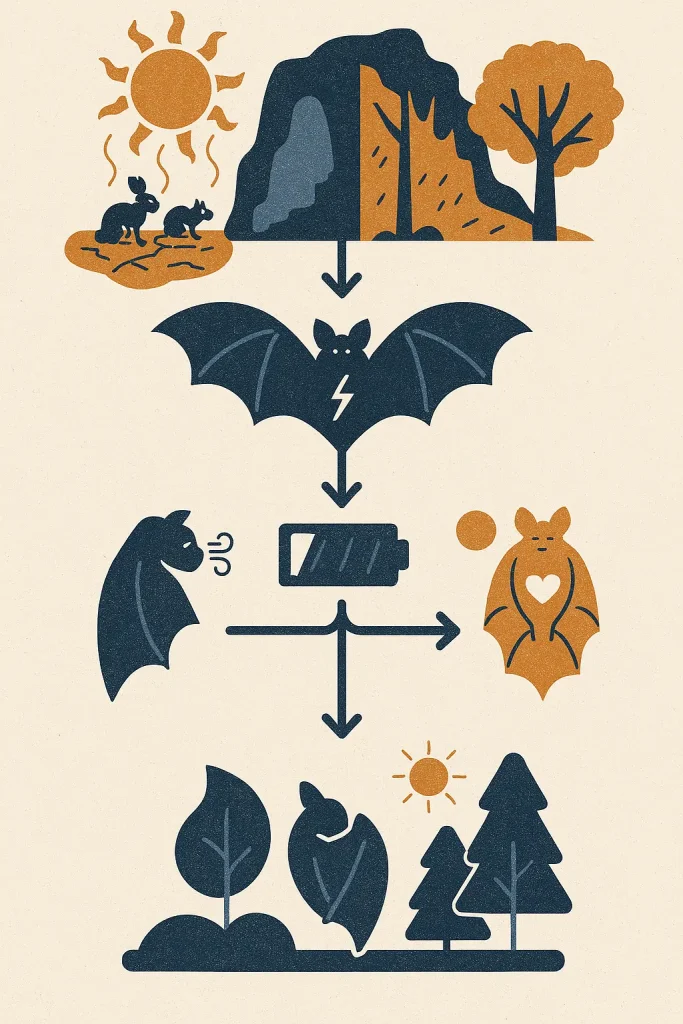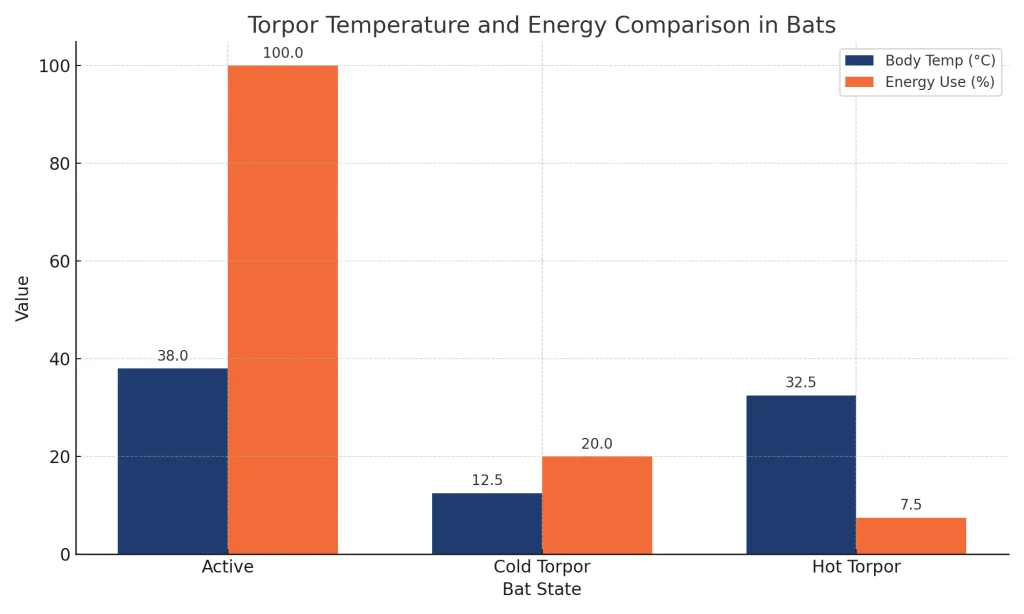Climate change isn’t just about melting glaciers and rising sea levels. It’s also about the small, nearly invisible shifts that challenge animals’ survival every day, especially in extreme environments. As temperatures rise and weather patterns become more unpredictable, many species struggle to find food, stay hydrated, and maintain their energy.
For some animals, especially small ones, this pressure is intense. Every beat of their heart, every breath they take, requires energy, making real-time climate adaptation a matter of survival. And when food is scarce, that energy runs out fast.
These insights come from a 2020 study by University of Hamburg biologist Sina Remmers, titled Ready for Climate Change?, which explores how the Malagasy bat Triaenops menamena survives harsh environments using an unusual strategy known as hot torpor.
But some animals don’t just survive, they adapt in ways that defy biology textbooks. And one tiny bat from Madagascar might be one of the most surprising examples yet.
Imagine a Mammal That Powers Down Like a Machine
Picture this: a bat the size of your hand, sleeping inside a hollow tree. Outside, the sun is blazing, and water is hard to find. But instead of panicking or fleeing, the bat “powers down”, lowering its metabolism to almost nothing, like a phone switching to low-power mode. Here’s the twist: it doesn’t get cold.
Normally, animals use a state called torpor to slow down their body functions and drop their body temperature to conserve energy. But this bat, Triaenops menamena, does something no biology textbook prepared us for.
It enters “hot torpor”, a state where it keeps its body warm while still conserving extreme amounts of energy. That’s like idling your car in the sun but using only a drop of gas per hour instead of gallons. And it’s real.
The Discovery: How Bats in Madagascar Adapt to Heat
Sina Remmers, a biologist from the University of Hamburg’s Institute for Zoology and Behavioral Biology, went deep into the forests and caves of Madagascar to study this phenomenon. Her mission: understand how Triaenops menamena copes with wildly different temperatures in its habitat.

And where did scientists discover this superpower? In Madagascar, a place bursting with strange and rare creatures, from leaf-tailed geckos to dancing lemurs.
Here’s what the research found:
- These bats use torpor differently depending on where they live.
In cool caves, their body temperature drops during torpor, just like most animals. But in hotter, forested areas, they stay warm sometimes over 35°C (95°F), even while drastically lowering their metabolism. - They save massive amounts of energy.
In some cases, these bats reduced their energy use by up to 95% during torpor, even without cooling down. That means they can survive long, hot days with almost no food or water. - They show flexible, in-the-moment adaptation, not evolution.
This isn’t a slow genetic change over generations. It’s something the bats do in real time, adjusting their bodies based on the daily weather. It’s like nature’s version of smart tech.
This rare form of climate adaptation, known as adaptive thermoregulatory flexibility, allows bats to survive extreme heat in real time.
But wait, why don’t all bats use hot torpor?
Hot torpor isn’t a feature that every bat can turn on. It’s shaped by where they live. In hot, dry forests where cooling down wouldn’t help much, staying warm while saving energy is a better survival strategy. In contrast, bats in cooler caves can afford to drop their temperature and still benefit from traditional torpor.
Why This Is Mind-Blowing (and Science Fair Gold)
Let’s pause for a second.
You’re probably used to thinking that animals evolve slowly to survive new environments. That’s true, but this research shows that some animals can adjust instead of evolve. And that makes Triaenops menamena one of the coolest animals on the planet.
Now, imagine turning this into a science project. You’re not just studying bats, you’re diving into a story about survival, innovation, and unexpected bat survival strategies that challenge traditional views of adaptation. You’ll be exploring:
- Real-world consequences of climate change.
- Animal strategies that defy biology class rules.
- A rare scientific concept few people, even your teachers, have heard of: hot torpor.
You’ll have graphs, quotes, maps of Madagascar, and cutting-edge research that shows you didn’t just Google something, you dug into real science.
“This is a remarkable form of physiological flexibility that helps bats survive in environments we assumed were too extreme,” said Remmers in her thesis.
Remmers emphasized that this form of hot torpor challenges conventional thermal biology, suggesting more animals may possess underexplored adaptive tools.
What Is Hot Torpor and How Does It Work?
Normally, torpor works like this:
Cold Torpor = Lower body temperature + slow metabolism → save energy.
But Triaenops menamena adds a twist:
Hot Torpor = Keep body temperature warm + still lower metabolism dramatically → still save energy, but stay ready to react if danger comes.
This is useful because:
- Staying warm helps them escape predators faster.
- They live in environments that are already hot, cooling down wouldn’t save much more energy.
- It might help with water conservation, a huge deal in dry forests.
This adaptation is smart, responsive, and represents a powerful example of energy-saving behavior in animals, a key to surviving climate extremes without evolutionary change.
The chart below shows how a bat’s body temperature and energy use differ between active, cold torpor, and hot torpor states.

Real-World Takeaways: What This Means for Students, Scientists, and the Planet
🔍 1. Nature Has Backup Plans
Animals like these bats show that life on Earth has surprising tools to survive sudden changes. Not everything is doomed, even in a warming world, there’s hope in how species adapt creatively.
“Some animals don’t evolve, they adapt instantly. That’s survival in real time.”🔁 Tweet This
📊 2. Torpor Isn’t One-Size-Fits-All
Science used to assume torpor always meant cooling down. This research expands our understanding. Torpor can look different in different species, and that’s an exciting mystery for future research.
🌿 3. Conservation Must Consider Flexibility
Conservation plans often rely on fixed data, where an animal lives, what it eats, and how it acts. But animals like Triaenops menamena show that behavior and physiology can shift. This means protecting a species requires understanding its range of responses, not just where it lives, but how it behaves. Recognizing climate adaptation in wildlife demands we account for flexible, context-based behavior like hot torpor.
🎓 4. Perfect Topic for Science Fairs or School Projects
You can build a project around:
- “How animals beat climate change with behavior, not genes.”
- “Weird adaptations in extreme environments.”
- “Comparing hot torpor and cold torpor with charts and videos.”
- “How bats are biological innovators.”
You could even create models or simulations to explain energy reduction in torpor states.
Bonus idea: Try observing animals in your local area. Do birds fluff their feathers more in the cold? Do squirrels behave differently in the summer? Small behaviors might hint at survival strategies just like torpor.
🧬 5. Science Isn’t Finished
This study was a Master’s thesis, not a massive university project or global study. That means you don’t have to wait to be a PhD to discover new things. Curious students like you can contribute to science by asking smart questions and looking at the natural world differently.
Why It Matters
The information above isn’t just theory, it has real-world implications that can drive results. By understanding and applying these insights, you can make better decisions, stay ahead of trends, and create more impactful strategies.
Key Takeaways
- Immediate Benefits – Apply this knowledge to improve performance and outcomes.
- Better Decision-Making – Stay informed with data-driven insights.
- SEO & Engagement Boost – Google rewards content that directly answers user needs.
- Practical Applications – Use this in real-world scenarios for maximum impact.
Why This Bat Discovery Redefines Climate Adaptation
What began as a study of tiny bats turned into a discovery that challenges how we understand temperature, metabolism, and survival. The takeaway?
Even small animals have big secrets, and some of the best science happens when someone decides to look closer.
So, if you’re thinking about a science project, why not choose a topic that literally changes what we thought we knew about biology?
After all, it’s not every day you get to say:
“I did a project on hot torpor, how bats stay warm and save energy in the heat. Want to see the data?”
This case of hot torpor doesn’t just expand our knowledge of bats, it broadens how we think about physiological flexibility in the face of environmental stress.
What’s the weirdest animal survival trick you’ve ever heard of? Drop it in the comments, we’re always looking for more strange science stories!
TL;DR
A tiny bat in Madagascar uses a rare strategy called hot torpor, lowering its energy use without cooling its body, to survive extreme heat, revealing a surprising form of real-time climate adaptation.
References
Geiser, F. (2004). Metabolic rate and body temperature reduction during hibernation and daily torpor. Annual Review of Physiology, 66, 239–274.
Ruf, T., & Geiser, F. (2015). Daily torpor and hibernation in birds and mammals. Biological Reviews, 90(3), 891-926.
Nowack, J., Stawski, C., & Geiser, F. (2017). More functions of torpor and their roles in a changing world. Journal of Comparative Physiology B, 187, 889–897.
Boyles, J. G., et al. (2011). Can behavioral thermoregulation buffer the impact of climate change on hibernating mammals? Ecology Letters, 14(2), 173–180.
Don’t miss these other new research findings as well.
